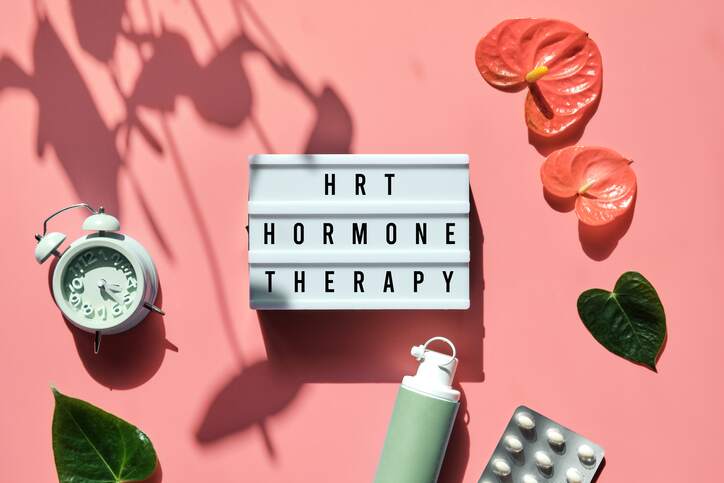Hormone Replacement Therapy (HRT) can be used for various reasons. For example, many transgender people may use HRT in this transitioning process.
Depending on their needs and body functioning, HRT is unique to the individual. This article will explore the concept of Hormone Replacement Therapy, and you can reference this guide since it will provide you with everything you need to know about HRT.
What are the types of hormone therapy?
Here are two common types of hormone therapy:
Feminizing hormone therapy: Feminizing hormone therapy (aka gender-affirming hormone therapy) is often undergone by transgender women and nonbinary people to create physical changes in the body caused by female hormones during puberty. Those changes are referred to as secondary sex characteristics. In addition, this hormone therapy will help align the body to match a person’s gender identity.
Feminizing hormone therapy requires a person to take medicine that blocks the action of the hormone testosterone. In addition, it involves taking the hormone estrogen; estrogen functions by lowering the amount of testosterone the body makes. As a result, it triggers the development of feminine secondary sex characteristics.
Masculinizing hormone therapy: Masculinizing hormone therapy (aka gender-affirming hormone therapy) is often used by transgender men and nonbinary people to create physical body changes caused by male hormones during puberty. Those changes are referred to as secondary sex characteristics. In addition, this hormone therapy assists in aligning the body to match a person’s gender identity.
During masculinizing hormone therapy, a person will take the male hormone testosterone. It ceases menstrual cycles and decreases the ovaries’ ability to create estrogen.
Some intersex people may also choose to pursue hormone therapy at any point in time. For example, whether they start earlier in childhood to affirm the sex they were assigned at birth or later in life to align their sex with their gender identity. Non-binary people also have the option to engage in hormone therapy to achieve a balance of sex hormones or to align their bodies with their gender identities.
What can I expect when I see the doctor for the first time?
During your first visit, your medical care provider will complete a full physical, including blood tests, taking your blood pressure, and discussing your medical history. In addition, they will provide resources about hormone therapy itself.
It is essential to consult with your doctor regularly to transition safely. An HRT regimen comes with potential risks, but these can be manageable under the guidance of a primary care provider.
When HRT is not suitable
HRT is not always suitable for everyone, or it may require the assistance of a specialist. Consider the following on whether or not HRT is right for you:
- You have a history of breast cancer, ovarian cancer, or uterine cancer
- A history of blood clots (tablet HRT is not recommended, but taking HRT through the skin may be an option)
- You have a history of heart disease or stroke
- Have untreated high blood pressure – it will need to be under control before you can start HRT
- You have liver disease
- are pregnant or breastfeeding
In certain circumstances, your doctor may prescribe different medications to help manage your menopausal symptoms.
What are the side effects of Hormone Replacement Therapy?
HRT can have some side effects. However, these side effects generally improve over time, so keep at the treatment for at least three months.
If the side effects continue to persist, you can make an appointment with your medical practitioner and consider alternatives.
Side effects from HRT can include:
- fluid retention
- bloating
- breast tenderness or swelling
- headaches
- indigestion
- depression
- vaginal bleeding
Some studies have also suggested that there could be risks depending on the following:
- Age. People who start hormone therapy at 60 or older or more than ten years from the onset of menopause are at higher risk for adverse outcomes. However, if hormone therapy is started before 60 or within ten years of menopause, the benefits can outweigh the risks.
- Type of hormone therapy. The risks of hormone therapy will be different depending on whether estrogen is given by itself or with progestin and the dose and type of estrogen.
- Health history. Your family history and medical history and if you have any risk of cancer, heart disease, stroke, blood clots, liver disease, and osteoporosis all come into play in determining whether hormone replacement therapy is the proper treatment for you.
It is essential to discuss any concerns with your medical provider and that they consider any potential risks before starting hormone therapy.
Takeaway
Even though Hormone Replacement Therapy can be an excellent option for transgender people transitioning, many trans and gender-diverse folks are happy with their bodies, and not everyone has to transition to be valid in their gender identity. Whether hormone therapy is right for you is a personal decision.
If you want more information about gender confirmation, we have extensive listings at LGBTQ and All.
For healthcare providers looking to become more visible to prospective transgender patients, list your business on our directory today.















